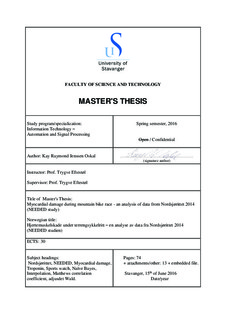| dc.contributor.advisor | Eftestøl, Trygve | |
| dc.contributor.author | Oskal, Kay Raymond Jenssen | |
| dc.date.accessioned | 2016-10-10T11:27:29Z | |
| dc.date.available | 2016-10-10T11:27:29Z | |
| dc.date.issued | 2016-06-15 | |
| dc.identifier.uri | http://hdl.handle.net/11250/2413920 | |
| dc.description | Master's thesis in Cybernetics and signal processing | nb_NO |
| dc.description.abstract | During Nordsjørittet 2014, blood samples, blood pressure and ECG were systematically
gathered from over 1000 contestants. With this gathering of data, there is an opportunity
to study the effects an endurance bike race has on presumably healthy individuals. In
addition to this data, there are complete data from sports watches from a third of these
contestants. When the medical analysis was done, 25 contestants were diagnosed with
myocardial damage. Eight of these were from those with sports watches.
The motivation for this thesis is to test if the data logged with the sports watches can
be used to predict myocardial damage. Or whether this data can be used to separate the
contestants with high or low troponin I values.
To achieve this, a classification system was designed to test if there are patterns in the
sports watch data that can be connected to myocardial damage or troponin I values.
As a consequence of variable sampling, the sports watch data were interpolated and
smoothed. After this pre-processing, several features were extracted from the sports
watches, from a predefined segment in the race. Two different methods, exhaused search
and sequential forward selection, were used to select the feature subset maximizing the
prediction rate. Furthermore, a Naive Bayes classifier was trained and validated using
leave-one-out cross-validation. To measure reliability of the results in the experiments,
Matthews correlation coefficient were used.
With an achieved prediction rate of 86% and a correlation coefficient of 0.58, the results
clearly indicates that the data logged in the sports watches can predict myocardial damage.
When testing if the sports watch data can separate the contestants with high or low
Tropinin I, the results were inconclusive. Therefore, it is uncertain if this is achievable
with the current data.
Fjern valgte | nb_NO |
| dc.language.iso | eng | nb_NO |
| dc.publisher | University of Stavanger, Norway | nb_NO |
| dc.relation.ispartofseries | Masteroppgave/UIS-TN-IDE/2016; | |
| dc.rights | Navngivelse 3.0 Norge | * |
| dc.rights.uri | http://creativecommons.org/licenses/by/3.0/no/ | * |
| dc.subject | kybernetikk | nb_NO |
| dc.subject | signalbehandling | nb_NO |
| dc.subject | informasjonsteknologi | nb_NO |
| dc.subject | NEEDED | nb_NO |
| dc.subject | naive bayes | nb_NO |
| dc.subject | myocardial damage | nb_NO |
| dc.subject | troponin | nb_NO |
| dc.subject | adjusted Wald | nb_NO |
| dc.subject | Mattews correlation coefficient | nb_NO |
| dc.subject | automatisering | nb_NO |
| dc.subject | Norsdsjørittet | nb_NO |
| dc.title | Myocardial damage during mountain bike race - an analysis of data from Nordsjørittet 2014 (NEEDED study) | nb_NO |
| dc.type | Master thesis | nb_NO |
| dc.subject.nsi | VDP::Technology: 500::Information and communication technology: 550::Technical cybernetics: 553 | nb_NO |

